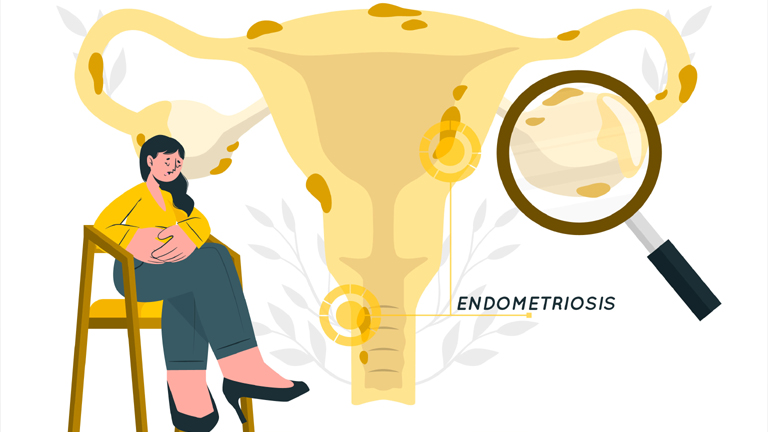Endometriosis is a chronic and often painful condition where tissue similar to the lining of the uterus (endometrium) grows outside the uterus. This condition affects approximately 1 in 10 women of reproductive age, leading to severe pelvic pain, infertility, and a diminished quality of life. Despite its prevalence, endometriosis remains underdiagnosed, with many women suffering for years before receiving proper treatment.
This comprehensive guide explores endometriosis pain management strategies and the latest treatment options, helping patients and healthcare providers make informed decisions.
Must Check: PCOS (Polycystic Ovary Syndrome)
Understanding Endometriosis: Causes and Symptoms
What Causes Endometriosis?
The exact cause of endometriosis remains unclear, but several theories exist:
-
Retrograde Menstruation: Menstrual blood flows backward into the pelvic cavity instead of exiting the body.
-
Genetic Factors: A family history increases the risk.
-
Immune System Dysfunction: The body fails to recognize and eliminate misplaced endometrial tissue.
-
Hormonal Influence: Estrogen promotes the growth of endometrial-like tissue.
Common Symptoms of Endometriosis
-
Severe pelvic pain (especially during menstruation)
-
Chronic lower back pain
-
Painful intercourse (dyspareunia)
-
Heavy or irregular periods
-
Infertility (30-50% of women with endometriosis struggle with conception)
-
Digestive issues (bloating, diarrhea, or constipation)
Early diagnosis is crucial to prevent complications like scar tissue formation and organ damage.
Diagnosing Endometriosis: Key Methods
Many women face delays in diagnosis due to symptom overlap with other conditions like irritable bowel syndrome (IBS) or pelvic inflammatory disease (PID). Diagnostic approaches include:
1. Pelvic Exam
Doctors check for cysts or scar tissue behind the uterus.
2. Ultrasound (Transvaginal or Abdominal)
Helps detect endometriomas (ovarian cysts caused by endometriosis).
3. MRI (Magnetic Resonance Imaging)
Provides detailed images of deep infiltrating endometriosis.
4. Laparoscopy (Gold Standard)
A minimally invasive surgery where a camera is inserted to visualize and biopsy endometrial lesions.
Endometriosis Pain Management Strategies
Managing endometriosis pain involves a multidisciplinary approach, combining medication, lifestyle changes, and alternative therapies.
1. Over-the-Counter (OTC) Pain Relievers
-
NSAIDs (Ibuprofen, Naproxen): Reduce inflammation and menstrual pain.
-
Acetaminophen (Paracetamol): Helps with mild to moderate pain.
Limitation: These only mask symptoms and don’t stop disease progression.
2. Hormonal Therapies
Hormonal treatments aim to suppress estrogen, slowing endometrial tissue growth:
-
Birth Control Pills (Combined Oral Contraceptives): Reduce menstrual flow and pain.
-
Progestin Therapy (Pills, IUDs, Injections): Thins the endometrial lining.
-
GnRH Agonists (Lupron, Zoladex): Induce temporary menopause to halt estrogen production.
Side Effects: Weight gain, mood swings, and bone density loss (with long-term GnRH use).
3. Surgical Options
-
Laparoscopic Excision Surgery: Removes endometriosis lesions while preserving organs.
-
Hysterectomy (Last Resort): Removal of the uterus (and sometimes ovaries) in severe cases.
4. Lifestyle and Natural Remedies
-
Anti-inflammatory Diet: Rich in omega-3s (salmon, flaxseeds), leafy greens, and turmeric.
-
Regular Exercise: Reduces inflammation and improves circulation.
-
Pelvic Floor Physical Therapy: Helps relieve muscle tension and pain.
-
Acupuncture and CBD Oil: Emerging as alternative pain relief methods.
New and Emerging Endometriosis Treatments
Research is advancing rapidly, offering new hope for endometriosis patients.
1. Elagolix (Orilissa)
-
A GnRH antagonist that reduces pain without inducing full menopause.
-
FDA-approved for moderate to severe endometriosis pain.
2. Relugolix (Myfembree)
-
A once-daily pill that lowers estrogen levels.
-
Also approved for uterine fibroids, showing promise for endometriosis.
3. Aromatase Inhibitors (Letrozole, Anastrozole)
-
Block estrogen production in stubborn cases.
-
Often combined with hormonal therapies.
4. Immunomodulators & Anti-inflammatory Drugs
-
TNF-alpha inhibitors and IL-6 blockers are being studied to reduce inflammation.
5. Stem Cell Therapy & Gene Editing
-
Experimental treatments aim to regenerate healthy tissue and correct genetic factors.
Endometriosis Pain Management & Treatment Options
| Category | Treatment Options | How It Works | Pros | Cons |
|---|---|---|---|---|
| OTC Medications | NSAIDs (Ibuprofen, Naproxen), Acetaminophen | Reduces inflammation and blocks pain signals. | Quick relief, easily accessible. | Doesn’t stop disease progression; long-term use harms stomach/kidneys. |
| Hormonal Therapy | Birth control pills, Progestins, GnRH agonists | Suppresses estrogen to slow endometrial growth. | Reduces pain, lighter periods. | Side effects (weight gain, mood swings, bone loss with GnRH agonists). |
| Surgery | Laparoscopic excision, Hysterectomy | Removes endometriosis lesions or uterus/ovaries. | Long-term pain relief; improves fertility (excision). | Risks of surgery; hysterectomy causes infertility. |
| Emerging Drugs | Elagolix, Relugolix, Aromatase inhibitors | Targets hormones or enzymes fueling endometriosis. | FDA-approved; effective for severe pain. | Expensive; side effects (hot flashes, fatigue). |
| Lifestyle Changes | Anti-inflammatory diet, Exercise, Acupuncture | Reduces inflammation and stress. | No side effects; improves overall health. | Requires consistency; not a standalone cure. |
| Fertility Treatments | IVF, IUI, Surgery | Bypasses scar tissue or stimulates ovulation. | Helps achieve pregnancy. | Costly; not always successful. |
Endometriosis and Fertility: What You Need to Know
Can You Get Pregnant with Endometriosis?
Yes, but it can be challenging due to:
-
Scar tissue blocking fallopian tubes
-
Inflammation affecting egg quality
-
Hormonal imbalances
Fertility Treatment Options
-
IVF (In Vitro Fertilization): Bypasses tubal blockages.
-
Laparoscopic Surgery: Improves fertility by removing lesions.
-
Ovarian Stimulation + IUI (Intrauterine Insemination): Enhances conception chances.
Long-Term Complications
If untreated, endometriosis may cause:
-
Chronic pelvic pain
-
Infertility (due to scar tissue blocking fallopian tubes)
-
Ovarian cysts (endometriomas)
-
Bowel/bladder dysfunction (in severe cases)
-
Increased risk of ovarian cancer (slightly higher in endometriosis patients)
Living with Endometriosis: Coping Strategies
1. Mental Health Support
-
Chronic pain can lead to anxiety and depression—therapy and support groups help.
2. Tracking Symptoms
-
Use apps like Flo or Clue to monitor pain cycles and triggers.
3. Workplace Accommodations
-
Discuss flexible hours or remote work options during flare-ups.
Conclusion: The Future of Endometriosis Care
Endometriosis is a complex condition, but awareness and research are growing. With new medications, advanced surgical techniques, and holistic pain management, women now have more options than ever.
If you suspect, consult a specialist—early intervention can prevent long-term damage and improve quality of life.
FAQs About Endometriosis
Q: Can endometriosis’s go away on its own?
A: No, but symptoms may improve after menopause.
Q: Is endometriosis’s cancerous?
A: No, but it can increase the risk of ovarian cancer slightly.
Q: What’s the best diet for endometriosis’s?
A: Anti-inflammatory foods (berries, nuts, fish) and avoiding processed foods help.
Q: Can exercise worsen endometriosis’s pain?
A: Gentle exercises (yoga, swimming) are beneficial, but high-intensity workouts may trigger pain.


